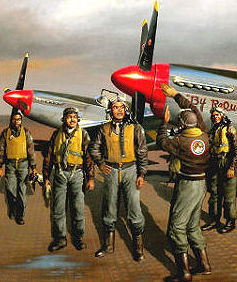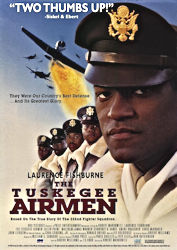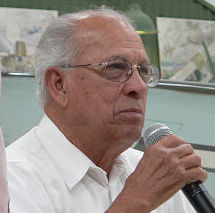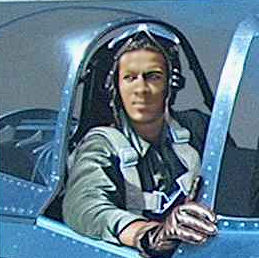
- HOME -
THE TUSKEGEE AIRMEN MEMORIALIZED ON CANVAS

The Tuskegee AirmenThe Real Pilots And Their Stories
|

Stan StokesArtist, biographer, author, historian, lecturer(Speaking at the Tuskegee program, Palm Springs Air Museum) "It was 1941 and many in America anticipated that we would eventually be in the war. At the time, black Americans were only allowed to serve in menial jobs regardless of their training, education or proven capabilities. Black, educated pilots demanded to be able to serve as such and after political pressure was brought to bear, the Roosevelt administration agreed." "These young men wanted to prove to their nation that blacks were equal to whites and took this opportunity to prove it. And prove it they did. Unfortunately after the war ended, upon returning home nothing had changed. Recognition of their accomplishments was a long time coming. It was not until the 1990s that the word, "Tuskegee Airmen" joined the American lexicon. It is our desire to continue this endeavor of bringing recognition to these great Americans and their contributions to our country." |

HBO Movie The Tuskegee AirmenWritten by Captain Bob WilliamsIowa, native, Captain Robert W. Williams, was a wartime pilot with the U.S. Army Air Corps' "332nd Fighter Group" of the Tuskegee Airmen. He wrote the original manuscript and was executive producer for the award winning 1995 HBO film "The Tuskegee Airmen" with the main character, Hannibal Lee, portrayed by Laurence Fishburne. This movie gives a good look at the first all black squadron of fighter pilots trained in Tuskegee, Alabama. The trials and tribulations of the "Fighting 99th" as they join the 332nd Fighter Group. They gained respect and much deserved recognition by escorting bombers over Germany. The Tuskegee Airmen received over 800 medals for their collective war efforts. A standard, but memorable WWII flick with its share of 'dog-fights'. Great efforts and expense were committed to make this movie as historically accurate as possible. |

|
Memorial MuralIn 1998, Bob Williams approached artist, Stan Stokes, with the idea of producing a memorial mural for the Tuskegee Airmen. After some discussion, Stan agreed. This project began in late 2000 and was finished a year later. It was then shipped from the Palm Springs Air Museum where it was delivered to Los Angeles International Airport, Northwest Air Terminal. It was on display for nearly a year. Subsequently it was returned to the Palm Springs Air Museum where it is on permanent display. The images on the mural are from WWII photographs of actual Tuskegee Airmen many of which came to view the progress of this marvelous work of art. Unfortunately Bob Williams passed away before the mural was completed. It is the goal of Stan Stokes to continue bringing recognition to the Tuskegee Airmen through paintings, books and lectures. |

Rusty BurnsTuskegee AirmanBurns received his aviation training at Tuskegee Institute and Air Base where he graduated in 1944 as a single engine pilot making him one of the youngest of the Tuskegee Airmen. He successfully completed his training in September of 1944 and became a member of the 99th Fighter Squadron at Godman's Field in Kentucky. Burns' military career ended in June of 1945 as World War II ended. 
After buying and rebuilding his own airplane Burns opened Rusty's Flying Service and began giving flight instructions at Compton Airport. He trained over five hundred students before selling his business in 1971 to become an aviation consultant. Rusty Burns from the Tuskegee MuralThis clip copied from the upper left hand corner of the mural shows Rusty in the cockpit of a P-47 Thunderbolt. |
|
CONTACT
Stan Stokes P.O. Box 11420 Palm Desert, CA 92255 |
Email: |
Click here for Stan's Website |

